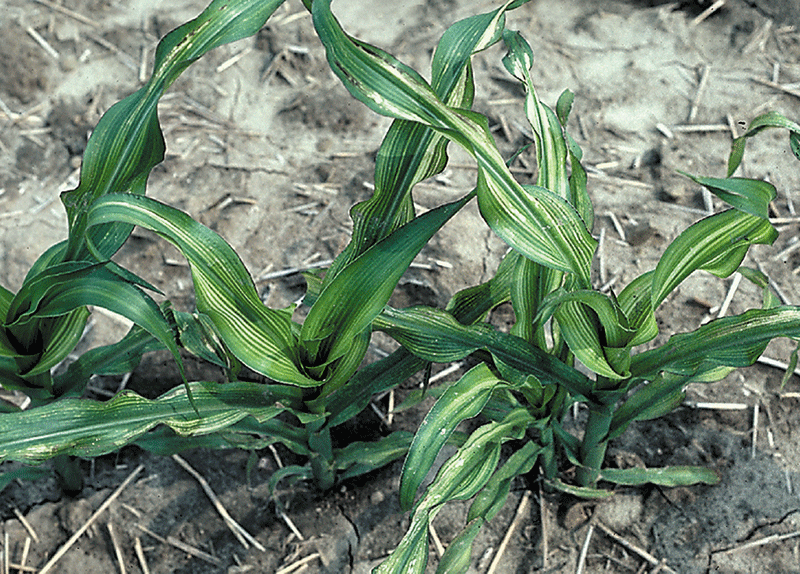Micronutrient deficiency risks
PRIORITIZE TESTING FIELDS AT BIGGEST RISK
WHILE CROPS DEMAND micronutrients such as boron, copper, iron, manganese, molybdenum, and zinc, in very small quantities, these are essential plant nutrients that can affect output significantly.
PHOTO: ZINC DEFICIENCY IN CORN.

In the U.S. Corn Belt and Great Lakes region, researchers are taking a new look to assess whether increasing crop output could be creating micronutrient deficiencies and hamstringing yields.
Recent studies across five states (Indiana, Iowa, Kansas, Minnesota, and Wisconsin) have confirmed that many soils currently have adequate micronutrient levels for corn and soybean production. Though high-yielding crops can remove more micronutrients from the soil, the growth in yield potential alone is not a reliable indicator that micronutrient fertilization is needed.
“Decisions about micronutrient fertilization could be better made by targeting fields with soils which traditionally have been identified with the likelihood of yield response, such as sandy, calcareous, organic, or severely eroded soils,” says Dr. Anthony Mallarino, Iowa State University.
WHICH FIELDS ARE AT HIGHEST RISK?
If research suggests most of the corn and soy growing regions have adequate micronutrient levels, should you be concerned about deficiencies on your farm?
“Micronutrients should receive attention once macronutrient and other major fertility considerations are well under control,” says Jake Munroe, Ontario Ministry of Agriculture, Food and Rural Affairs soil fertility specialist.
Munroe outlines the main micronutrient concerns for Ontario farmers.
- Zinc deficiency can be a concern for corn in high pH, low organic matter soils, where it tends to show up in pockets within a field.
- Manganese deficiency can be an issue in soybeans and wheat under high pH, low organic matter conditions but also in low-lying areas with high organic matter. Watch for visual symptoms and address deficiencies as soon as possible — foliar manganese application is effective.
- Boron is essential for alfalfa in relatively large amounts compared to other crops. Deficiencies can occur in sandy, low organic matter soils and in dry conditions. There is also evidence that canola will respond to foliar boron application in some instances.
RECENT U.S. RESEARCH FINDINGS
Identifying fields low in certain micronutrients (or observing a deficiency in the field) is only half of the problem, of course. How do you decide when to apply nutrients? Recent U.S. research suggests that a micronutrient application isn’t always economical, and applying micronutrients in the absence of a deficiency will not boost yields.
Studies in Indiana on high yielding soybeans concluded that neither banded nor foliar molybdenum application increased seed yield significantly, but soybean yields on deficient soils increased by as much as six bushels per acre when molybdenum was applied with nitrogen and phosphorus in a starter fertilizer.
Recent Iowa studies found both small yield increases and decreases from banded zinc application to corn that was not related to soil-test zinc levels. In three projects looking at more than 30 Iowa soil series, no micronutrient produced a statistically significant grain yield increase under conventional tillage. Iowa researchers also concluded that the published soil or plant-tissue test interpretations often call for unneeded micronutrient fertilization.
Kansas scientists looking at the performance of micronutrient blends on field with no history of deficiencies found no early growth or yield increases in corn or soybeans that could be attributed to the micronutrients.
In Minnesota, where iron deficiency chlorosis (IDC) has been an issue, studies found a three-pound application of Soygreen increased soybean yields but lower applications did not. Because of the product’s cost, researchers suggest targeting its use to areas with the greatest IDC problems.
Wisconsin studies found no soybean yield increases from manganese applied as a starter or foliar treatment and concluded that manganese application is probably not economical on manganese deficient soils if there are no visible signs of deficiency in crops. •






















